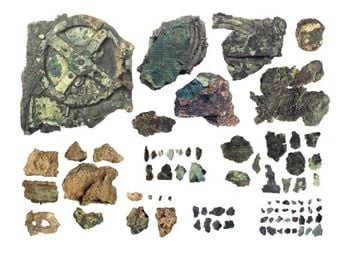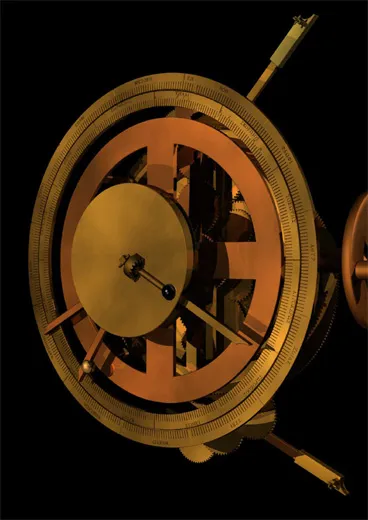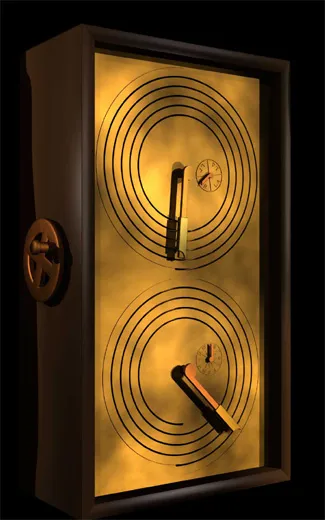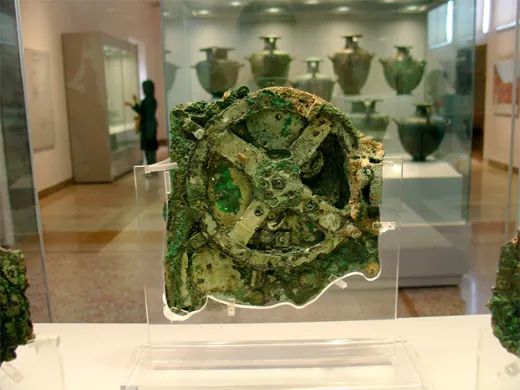Old World, High Tech
An ancient Greek calendar was ahead of its time
In 1900, Greek divers rifling through an ancient shipwreck recovered dozens of bronze fragments that turned out to be parts of a 2,000-year-old mechanical calendar. Now, more than a century after that discovery, scientists who studied these pieces are hailing the device as remarkably advanced for its time.
Using computer imaging techniques previously unavailable to researchers, a team led by mathematician Tony Freeth of the University of Cardiff reconstructed the Greek instrument, known as the Antikythera Mechanism, from the 82 recovered fragments. The original mechanism involved 37 gear-wheels held together by a complex pin-and-slot system, the researchers report in the Nov. 30 Nature.
One section of the instrument's gear systems predicted lunar and solar eclipses, another synchronized lunar months and solar years. A large gear in the middle indicated the position of the moon.
"The Antikythera Mechanism is the most sophisticated such object yet found from the ancient and medieval periods," writes François Charette of Ludwig-Maximilians University in Germany in a commentary accompanying the paper.
Freeth's team deciphered previously illegible inscriptions on the wooden walls that housed the mechanism. Based on these markings, the calendar likely dates to about 150 B.C., the researchers report.
Physical evidence of an ancient technology is rare, says professor of Greek and Roman studies John Humphrey of the University of Calgary, who recently published a book on the subject. Most early devices are known from writings describing the machines, which may or may not have been built.
"That's what makes the Antikythera Mechanism different," he says.
Humphrey, who was not part of the new research study, highlights some other intriguing early technologies:
The Bottomless Wine Glass
Inventor: Hero of Alexandria
Date: Around 65 A.D.
How it works: The goblet is connected to a reservoir by a tube. As a person drinks wine, the liquid level in the reservoir falls, releasing a plug coming from a hidden reservoir. As the liquid levels replenish—perhaps between gulps—the plug once again stops the hidden reservoir.
Proof of complexity: Several of Humphrey's engineering students have been unable to replicate the device's complex plug.
Quirk: "The trouble is, you have to drink the wine through a straw," Humphrey says.
Automatic Temple Door
Inventor: Hero of Alexandria, again
Date: First century A.D.
How it works: A worshipper lights a fire on an altar. The fire heats the air, which increases its volume. The heavier air causes a container of water to flow into a bucket. As the bucket fills, a series of pulleys and gears lifts the temple door.
Proof of complexity: The applied physical principles of pneumatics.
Quirk: "I doubt it if was ever constructed," Humphrey says.
World's First Vending Machine
Inventor: Hero (busy man)
Date: First century A.D.
How it works: A person puts a coin in a slot at the top of a box. The coin hits a metal lever, like a balance beam. On the other end of the beam is a string tied to a plug that stops a container of liquid. As the beam tilts from the weight of the coin, the string lifts the plug and dispenses the desired drink until the coin drops off the beam.
Proof of complexity: Early modern vending machines actually used a similar system, before electrical machines took over.
Quirk: It was devised to distribute Holy Water at temples, because "people were taking more Holy Water than they were paying for," Humphrey says.
Double-action Piston Pump
Inventor: Ctesibus
Date: Third century B.C.
How it works: Two pistons rest in cylinders attached to a handle. As one piston is raised, the other falls. The rising piston allows water to enter a chamber. The falling piston presses the water out of the other side in a constant stream.
Proof of complexity: Such a device is a predecessor of the modern engine. Quirk: With the addition of a nozzle on one end, the device was subsequently turned into a fire-fighting tool—by none other than Hero.
/https://tf-cmsv2-smithsonianmag-media.s3.amazonaws.com/accounts/headshot/eric-jaffe-240.jpg)







/https://tf-cmsv2-smithsonianmag-media.s3.amazonaws.com/accounts/headshot/eric-jaffe-240.jpg)